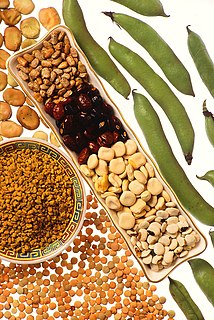
The Fabaceae or Leguminosae, commonly known as the legume, pea, or bean family, are a large and economically important family of flowering plants. It includes trees, shrubs, and perennial or annual herbaceous plants, which are easily recognized by their fruit (legume) and their compound, stipulate leaves. Many legumes have characteristic flowers and fruits. The family is widely distributed, and is the third-largest land plant family in terms of number of species, behind only the Orchidaceae and Asteraceae, with about 751 genera and about 19,000 known species. The five largest of the genera are Astragalus, Acacia, Indigofera, Crotalaria, and Mimosa, which constitute about a quarter of all legume species. The ca. 19,000 known legume species amount to about 7% of flowering plant species. Fabaceae is the most common family found in tropical rainforests and in dry forests in the Americas and Africa.

Lupinus polyphyllus is a species of lupine (lupin) native to western North America from southern Alaska and British Columbia east to Quebec, and western Wyoming, and south to Utah and California. It commonly grows along streams and creeks, preferring moist habitats.

Lupinus arboreus, common name yellow bush lupine (US) or tree lupin (UK), is a species of flowering plant in the legume family Fabaceae.
In computer architecture, 4-bit integers, memory addresses, or other data units are those that are 4 bits wide. Also, 4-bit CPU and ALU architectures are those that are based on registers, address buses, or data buses of that size. A group of four bits is also called a nibble and has 24 = 16 possible values.
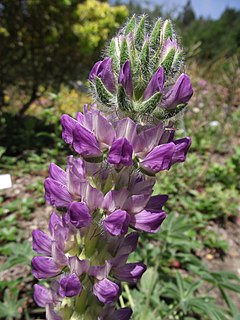
Lupinus microcarpus, the wide-bannered lupine or chick lupine, is a species of lupine native to western North America from southwestern British Columbia south through Oregon and California, including the Mojave Desert, and into Baja California. There is also a disjunct population in South America, with locations in central Chile and western Argentina.

Lupin or lupini beans are the yellow legume seeds of the genus Lupinus. They are traditionally eaten as a pickled snack food, primarily in the Mediterranean basin and Latin America. The bitter variety of the beans are high in alkaloids and are extremely bitter unless rinsed methodically.
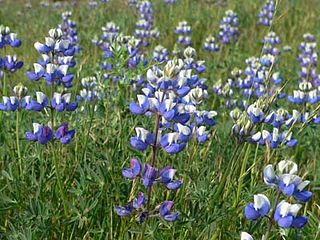
Lupinus nanus, is a species of lupine native to the western United States. It is found natively in California, Nevada, and on Steens Mountain in eastern Oregon. It tends to be found growing on slopes and in open or disturbed areas below 1300 meters. It grows 6 to 20 inches tall with blue flowers containing white or yellow spots. It is an annual plant that blooms in the months of March, April and May. It contains anagyrine and is considered toxic if directly ingested. Among the biologically active chemicals found in the pant are genistein, 2'-hydroxygenistein, luteone and wighteone.

Lupinus albus, commonly known as the white lupin or field lupine, is a member of the genus Lupinus in the family Fabaceae. It is a traditional pulse cultivated in the Mediterranean region.

Lupinus angustifolius is a species of lupin known by many common names, including narrowleaf lupin, narrow-leaved lupin and blue lupin. It is native to Eurasia and northern Africa and naturalized in parts of Australia and North America. It has been cultivated for over 6000 years as a food crop for its edible legume seeds, as a fodder for livestock and for green manure.
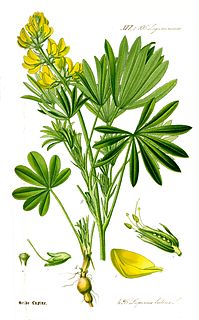
Lupinus luteus is known as annual yellow-lupin, European yellow lupin or yellow lupin. It is native to the Mediterranean region of Southern Europe. It occurs on mild sandy and volcanic soils in mining belts. As a wild plant, it is widespread over the coastal area in the western part of the Iberian Peninsula, Morocco, Tunisia, and Algeria, on the islands of Corsica, Sardinia and Sicily and in Southern Italy. It is most likely that in Israel and Lebanon it has turned wild. Cultivated in Northern Europe and the CIS as well as, on a smaller scale, in Western Australia and South Africa. Having previously been cultivated in southern France and on Madeira, it has turned wild there. Using combinations of such characters as the colour of the corolla, the carina’s edge, vegetative organs and seeds, 18 varieties, 4 subvarieties and 6 forms have been identified. The plant's yellow seeds, known as lupin beans, were once a common food of the Mediterranean basin and Latin America. Today they are primarily eaten as a pickled snack food.
Lupinus latifolius var. barbatus, the Klamath lupine, sometimes also called bearded lupine, is a very rare plant of the Western U.S., known only from northeastern California and southeastern Oregon. It is a rare variety of the generally common species L. latifolius, which is a member of the bean family.

Lupinus nootkatensis, the Nootka lupine, is a perennial plant of the genus Lupinus in the legume family, Fabaceae. It is native to North America. The Nootka lupine grows to 60 cm tall. Late in the 18th century it was first introduced to Europe.
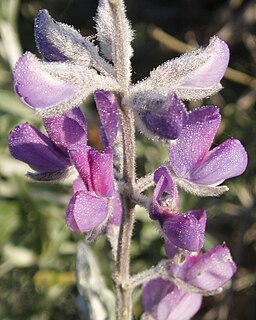
Lupinus chamissonis is a species of lupine known by the common name Chamisso bush lupine. It is endemic to California, where it is known from most of the length of the coastline. It grows in sand dunes and other immediate coastal habitat.

Bluebonnet is a name given to any number of purple-flowered species of the genus Lupinus predominantly found in southwestern United States and is collectively the state flower of Texas. The shape of the petals on the flower resembles the bonnet worn by pioneer women to shield them from the sun. Species often called bluebonnets include:

SM Lanang Premier, also known locally as SM Lanang, is an indoor four-story shopping mall in Lanang, Davao City, Philippines along Jose P. Laurel Avenue and within S.P Dakudao loop. It is the first SM Supermall to be called "Premier". The mall is owned by Henry Sy, Sr. and managed by SM Prime Holdings. Construction of the mall started in 2011 and opened to the public on September 28, 2012, on the site of the former Lanang Golf and Country Club.

Lupinus arcticus is a species of flowering plant in the legume family known by the common names Arctic lupine or subalpine lupine. It is native to northwestern North America, where it occurs from Oregon north to Alaska and east to Nunavut. It is a common wildflower in British Columbia.
Francisco Tamayo Yepes was a Venezuelan botanist.

Lupinus lepidus, the Pacific lupine, prairie lupine or dwarf lupine is a perennial herbaceous plant in the pea family (Fabaceae) endemic to western North America.
Ira Waddell Clokey (1878-1950) was an American mining engineer and botanist active in the western United States. He first studied at the University of Illinois, then moved to Harvard University, graduating with a Bachelor of Science in mining engineering in 1903. From 1904 to 1915, Clokey worked as a mining engineer in Mexico. In his spare time he collected plant specimens for his personal herbarium, which, however, was almost completely destroyed during a fire in 1912. In 1921, Clokey completed a Master of Science in plant pathology from Iowa State University.

